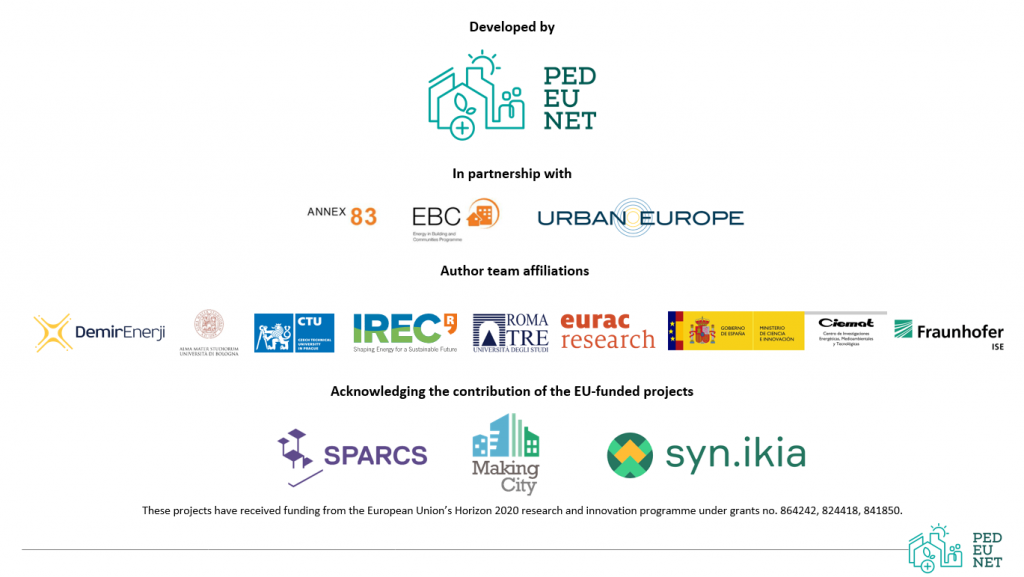| D1P001: Name of the project | |
| D1P001: Name of the project | PED urban - Development of methods and tools for accounting, planning and operation of climate-neutral district |
| D1P002: Project assigned code | |
| D1P002: Project assigned code | 03EN3048A |
| D1P003: Start date | |
| D1P003: Start date | 11/21 |
| D1P004: End date | |
| D1P004: End date | 11/24 |
| D1P005: Ongoing project | |
| D1P005: Ongoing project | Yes |
| D1P006: Funding programme/financing model | |
| FP7/H2020/HEU/DUT | no |
| Interreg | no |
| National funding | yes |
| National funding | |
| Public-Private Partnership - please specify | no |
| Other | no |
| D1P007: Estimated project costs (Mill. €) | |
| D1P007: Estimated project costs (Mill. €) | 1.9 |
| D1P008: Description of project objectives/concepts | |
| D1P008: Description of project objectives/concepts | In order to achieve climate neutrality in Germany, cities and neighborhoods must also become climate neutral. The European Union is supporting the transformation of districts by demonstrating 100 Positive Energy Districts (PEDs) by 2025. PED-urban is working on the open research questions in the area of PED districts and developing solutions to support the realization of climate-neutral PED districts in Germany. Climate neutrality is particularly difficult to achieve for urban districts with a high energy density and when the local renewable energy potential is not sufficient to meet the demand. This is the focus of the project's investigations by developing a PED definition that takes these framework conditions into account. The planning and development of PED districts requires improved digital planning tools. PED-urban is developing these further and applying them in two demo districts. The transformation of existing neighborhoods with an existing energy infrastructure also poses a particular challenge, as the various professional and private stakeholders in the neighborhood must be won over to the implementation of the transformation roadmap. This must take into account the views and options for action of the property decision-makers, for example, which is why their willingness to change their energy supply is examined in social science studies. The regulatory environment plays a decisive role in the possible business models; in particular, the energy communities that have been agreed within the framework of EU directives will play an important role for district solutions in the future. Their influence is therefore being investigated in the project. The development of PED districts is being promoted worldwide, and PED-urban supports the international exchange of research results in the IEA-EBC Annex 83 on PEDs. |
| D1P009: Description of project upscaling strategies/potential | |
| D1P009: Description of project upscaling strategies/potential | The assessment framwork for PEDs which is developed in ped urban can be used german wide to assess districts for their ped compability and help them to become climate neutral as well as to reach other goals within the ped framework. |
| D1P010: Number of PED case studies in the project | |
| D1P010: Number of PED case studies in the project | 2 |
| D1P011: Case Study | |
| D1P011: Case Study | |
| D1P012: Description of project expected impact | |
| D1P012: Description of project expected impact |
|
| D1P013: Standardization efforts | |
| D1P013: Standardization efforts | Common PED assessment methods and PED archetypes |
| D1P014: Sources | |
| D1P014: Sources | |
| D1P015: Can you specify a suitable contact person regarding the load-management approach within your PED project? | |
| Name | Gerhard Stryi-Hipp and Dr. Annette Steingrube |
| annette.steingrube@ise.fraunhofer.de | |
| D1P016: Would you be willing to share data from your PED project for research purposes? | |
| D1P016: Would you be willing to share data from your PED project for research purposes? | Yes |

Authors (framework concept)
Beril Alpagut (Demir Energy); Giulia Turci (University of Bologna); Michal Kuzmic (Czech Technical University in Prague); Paolo Civiero (Università Roma Tre); Serena Pagliulia (University of Bologna); Oscar Seco (CIEMAT); Silvia Soutullo (CIEMAT); Daniele Vettorato (EURAC Research, IEA Annex 83); Bailador Ferreras M. Almudena (CIEMAT); Vicky Albert-Seifried (FHG ISE)
Contributors (to the content)
Laura Aelenei (LNEG), Nienke Maas (TNO), Savis Gohari (OsloMet), Andras Reith (ABUD), Ghazal Etminan (AIT), Maria-Beatrice Andreucci (Universita Sapienza), Francesco Reda (VTT, IEA Annex 83), Mari Hukkalainen (VTT), Judith-Borsboom (Locality), Gilda Massa (ENEA), Jelena Ziemele (University of Latvia), Nikola Pokorny (CVUT), Sergio Diaz de Garayo Balsategui (CENER, IEA Annex 83), Matthias Haase (ZHAW, IEA Annex 83), Christoph Gollner (FFG, JPI UE), Silvia Bossi (ENEA, JPI UE), Christian Winzer (Zurich University of Applied Science), George Martinopoulos (Centre for Research and Technology Hellas), Maria Nuria Sánchez (CIEMAT), Angelina Tomova (Energy Agency of Plovdiv), Oya Tabanoglu (Demir Enerji), Jelena Brajković (University of Belgrade), Juveria Shah (Dalarna University), Michela Pirro (ENEA), Francesca Sabatini (University of Bologna)
Implemented by
Boutik.pt: Filipe Martins, Jamal Khan
Marek Suchánek (Czech Technical University in Prague)